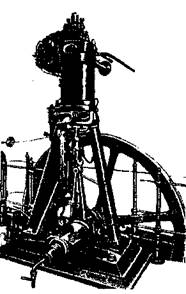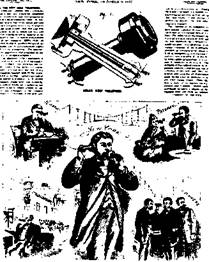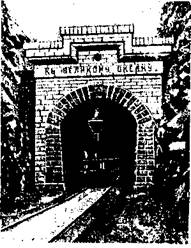home
 Economy Economy
 Books Books
 History of the world economy - Polyak GB History of the world economy - Polyak GB
|
History of the world economy - Polyak GB
IV. THE LATEST TIME
26. The second scientific and technological revolution and the development of the world's productive forces (late XIX - early XX centuries).
Development of the world's productive forces in the late XIX-early XX centuries. (So, the total steel output from 1870 to 1900 increased by 20 times), as a result of which the volume of world industrial production increased. Quantitative changes were accompanied by rapid development of technology, innovations that covered various areas of production, transport, life. Radical changes occurred in the organization of industrial production, its technology. Many new industries appeared, which the world had not previously known. There have been significant changes in the allocation of productive forces both between countries and within individual states.
Such a leap in the development of world industrial potential is connected with the revolution that took place in the period under review.
The Scientific Revolution
To the turn of the XIX-XX centuries. The fundamentals of scientific thinking have fundamentally changed; The natural science is flourishing, a unified system of sciences is being created. This was facilitated by the discovery of the electron and radioactivity. A new scientific revolution has begun, which began in physics and embraced all the main branches of science. It is represented by M. Planck, who created the quantum theory, and A. Einstein, who created the theory of relativity, which marked a breakthrough in the field of the microworld.
In the late XIX-early XX centuries. The connection between science and production has become more stable and systematic; A close relationship between science and technology is established, which determines the gradual transformation of science into a direct productive force of society. If before the end of the XIX century. Science remained "small" (in this sphere a small number of people were employed, at the turn of the 20th century the way of organization of science changed - large scientific institutes and laboratories equipped with a powerful technical base emerged. "Small" science turns into a "large" - the number of people employed in This sphere has increased, special units of research activity have arisen, the task of which was the prompt delivery of theoretical solutions to the technical implementation, including experimental design, production research, technological, experimental and other.
The process of revolutionary transformations in the field of science then encompassed technology and technology.
Electricity
On the basis of electricity, a new energy base for industry and transport was created, i. Solved the biggest technical problem. In 1867, in Germany, V. Simens invented an electromagnetic generator with self-excitation, which by means of the rotation of a conductor in a magnetic field it is possible to obtain and produce an electric current. In the 70-ies. A dynamo machine was invented , which could be used not only as an electric power generator, but also as an engine that turns electrical energy into a mechanical one. In 1883, Edison (USA) created the first modern generator. The next successfully solved problem is the transmission of electricity by wires over considerable distances (in 1891 Edison created a transformer). Thus, a modern technical chain has developed: receiving - transferring - receiving electricity, so that industrial enterprises could be located away from energy bases. Electricity production was organized at special enterprises - power plants.

Dynamo machine
First, electricity to workplaces was sent by electric drive, which was common for the entire engine complex. Then he became a group and, finally, an individual. From that moment, each machine had a separate engine. Equipment of machines with electric motors increased the speed of machines, increased labor productivity and created the prerequisites for the subsequent automation of the production process.
As the demand for electricity steadily increased, the technical thought was occupied with the search for new types of primary engines: more powerful, more fast, compact, economical. The most successful invention was the multistage steam turbine of the English engineer C. Parsons (1884), which played a significant role in the development of energy - it allowed many times to increase the speed of rotation.
Along with thermal turbines, the development of hydraulic turbines went ; They were first installed at the Niagara hydropower plant in 1896, one of the largest power plants of that time.
Especially important were the internal combustion engines. Models of such engines, working on liquid fuels (gasoline), were created in the mid-80s by German engineers G. Daimler and K. Benz. These engines were used by motor track transport.
In the years 1896-1987. German engineer R. Diesel invented an internal combustion engine with a large coefficient of efficiency. Then it was adapted to work on heavy liquid fuels and received exceptionally wide application in all branches of industry and transport. In 1906 tractors with internal combustion engines appeared in the USA. Their application in agriculture began in 1907. Mass production of such tractors was mastered during the First World War.

Experienced Diesel engine
Electrical Engineering
One of the leading branches is electrical engineering, its sub-sectors are developing. Thus, electric lighting is widespread, caused by the construction of large industrial enterprises, the growth of large cities, and the increased production of electricity.
The invention of the incandescent lamp belongs to Russian scientists: A.N. Lodygin (incandescent lamp with a carbon rod in a glass flask, 1873) and P.N. Yablochkov (the design of an electric arc lamp, an "electric candle", 1875).
In 1879, the American inventor T. Edison proposed a vacuum incandescent lamp with a carbon filament. In the future, the inventors of various countries made improvements in the design of incandescent lamps. Thus, A. N. Lodygin developed lamps with metallic threads, including those with tungsten filaments, which are still in use today. Although gas lighting was maintained in many countries for a long time, it could no longer resist the spread of electric lighting systems.
The second scientific and technological revolution is a period of wide development and a branch of electrical engineering, such as communication technology . At the end of XIX century. The equipment of the wire telegraph was significantly improved, and by the beginning of the 1980s, great work was done on the design and practical application of telephone equipment. The inventor of the phone was the American AG Bell, who received the first patent in 1876. The microphone that was not in the Bell apparatus was invented by T. Edison and independently by the Englishman D. Hughes. Thanks to the microphone, the range of the telephone was increased. Telephone communication began to spread rapidly in all countries of the world. The first telephone exchange in the United States was built in 1877.

Report on Bell's phone in "Scientifically America"
Two years later, a telephone exchange was put into operation in Paris, in 1881 - in Berlin, Petersburg, Moscow, Odessa, Riga and Warsaw. The automatic telephone exchange was patented by American AB Strouger in 1889.
One of the most important achievements of the second scientific and technological revolution is the invention of radio wireless telecommunications, based on the use of electromagnetic waves (radio waves). These waves were first discovered by the German physicist H. Hertz. The practical creation of such a connection was made by an outstanding Russian scientist. Popov, who demonstrated on May 7, 1885, the world's first radio receiver. Then the transmission to the distance of the radiogram followed, in 1897, a telegraph connection was made between the ships at a distance of 5 km. In 1899, a sustained long transmission of radiograms at a distance of 43 km was achieved.
The Italian engineer G. Marconi in 1896 patented the method of transmitting electrical impulses without wires. Significant material support of the British capitalist circles allowed him in 1899 to transfer through the English Channel, and in 1901 - through the Atlantic Ocean.
In the early XX century. Was born one more branch of electrical engineering - electronics. In 1904 the English scientist JA Fleming developed a two-electrode lamp (diode) that could be used to convert the frequencies of electrical oscillations. In 1907, the American designer Lee de Forest proposed a three-electrode lamp (triode), with which it was possible not only to convert the frequency of electrical oscillations, but also to amplify weak oscillations. The beginning of industrial electronics was put by the introduction of mercury rectifiers for the conversion of an alternating current into a constant one.
Thus, the industrial application of electric power, the construction of power plants, the expansion of electric lighting of cities, the development of telephone communications, etc. The rapid development of the electrical industry.
Metallurgy
The second STR was marked not only by the creation of new industries, but also affected the old industries, primarily metallurgy. Rapid development of the productive forces - machine building, shipbuilding, military production, rail transport - demanded ferrous metals. In metallurgy, technical innovations were introduced, the technique of metallurgy achieved tremendous success. Significantly changed the design and increased the volume of blast furnaces. New methods for the production of steel were introduced by redistributing cast iron in a converter under strong blowing (G. Bessemer, England, patent 1856) and in a special furnace for cast steel (P. Marten, France, 1864). The English metallurgist C. Thomas in 1878 proposed to use iron ore with large impurities of phosphorus for smelting steel. This method allowed to release the metal from the impurities of sulfur and phosphorus.
In the 1980s, an electrolytic method for the production of aluminum was introduced, which enabled the development of non-ferrous metallurgy. The electrolytic method was also used to produce copper (1878). These methods formed the basis of modern steelmaking, although the Thomas method in the second half of the XX century. Was superseded by the oxygen-converter process.
Transport
The most important direction of the second scientific and technological revolution was transport - new modes of transport appeared and the existing means of communication were improved.
Such practical needs as the growth of volumes and the shortage of traffic, contributed to the improvement of railway equipment. In the last decades of the XIX century. The transition to steel rail rails was completed. Steel was increasingly used in the construction of bridges. "The era of steel bridges" opened an arch bridge, built in the US in 1874 through the river. Mississippi near the city of St. Louis. Its author is J. Ide. The carriageway of the suspended Brooklyn Bridge (near New York) with a central span of 486 m was supported by steel ropes. The Gate-Gate arched bridge in New York was built in 1917 entirely of ligated steel (high-carbon). The largest steel bridges were erected in Russia through the Volga (1879) and Yenisei (1896) under the supervision of the engineer of the National Academy of Sciences. Bogolyubsky. Since the 80s, the construction of bridges along with steel began to use reinforced concrete more widely.

The bridge across the river. Irtysh on the West-Siberian Railway
On the railways laid in the Alps, the largest tunnels were dug : Saint Gotard (1880), Simgoyunsky (1905). The most significant of the submarine tunnels was the seven-kilometer Severnsky tunnel in England (1885).
In the same years, tunnels were built in Russia: through the Suram mountain range in the Caucasus, the Yablonevy Range in the Far East, and others.

Entrance to the tunnel, laid through the Yablonevy Ridge
The rolling stock on the railways was improved - the capacity, tractive power, speed, weight and dimensions of locomotives, the carrying capacity of wagons increased sharply. Since 1872, automatic brakes have been introduced in railway transport, and in 1876 an automatic coupling design was developed.
At the end of XIX century. In Germany, Russia, the United States, experiments were conducted on the introduction of electric traction on the railways. The first electric city tram line was opened in Germany in 1881. In Russia, the construction of tram lines began in 1892. In the 1990s, suburban and intercity electric railways appeared in a number of countries. However, railway, coal, and oil companies actively opposed this.
The fleet was developing . Since the 1960s, piston steam engines with multiple expansion of steam have been used on marine vessels. In the years 1894-1895. The first experiments on the replacement of piston engines with steam turbines were carried out. We also strived to increase the power and speed of marine and oceanic steam vessels: the crossing of the Atlantic Ocean was now possible in seven to five days. They started construction of ships with internal combustion engines - motor ships. The first ship, the Vandal oil tanker, was built by Russian designers in 1903. In Western Europe, the construction of motor ships began in 1912. The largest event in the development of maritime transport was the construction in 1914 of the Panama Canal, which had not only economic but also political and Military importance.

English fashionable steamer "Titanic"
A new type of transport, born in the era of the second scientific and technical revolution, is automobile. The first cars were designed by German engineers K. Benz and G. Daimler. Industrial production of cars began in the 90s, and in several countries. Contributed to the success of the automobile invention in 1895 by the Irish engineer J. Danlop rubber tires. High rates of development of motor industry led to the construction of highways.
A new type of transport of the turn of the XIX and XX centuries. - air. It is subdivided into lighter-than-air devices - airships and heavier than air - airplanes (airplanes). In 1896, the German designer G. Selfert used for airships an internal combustion engine that operated on liquid fuel, which contributed to the development of airship construction in many countries. But the decisive role in the development of air transport played the aircraft.
Russian scientists and inventors, the founders of modern hydro and aerodynamics DI Mendeleyev, L. M. Pomortsev, S.K. Dzhevetsky, KE Tsiolkovsky, and especially NE Zhukovsky. Great credit in mastering the technique of flying belongs to the German engineer O. Lilienthal.
The first experiments on designing aircraft with steam engines were carried out by AF Mozhaisky (1882-1885, Russia), K. Ader (1890-1893, France) H. Maxim (1892-1894, USA). The wide development of aviation became possible after the establishment of light and compact gasoline engines. In 1903, in the United States, the brothers W. and O. Wright flew four flights on an airplane with an internal combustion engine. At first, airplanes were of sporting value, then they were used in military affairs, and then for the transportation of passengers.


Comments
When commenting on, remember that the content and tone of your message can hurt the feelings of real people, show respect and tolerance to your interlocutors even if you do not share their opinion, your behavior in the conditions of freedom of expression and anonymity provided by the Internet, changes Not only virtual, but also the real world. All comments are hidden from the index, spam is controlled.